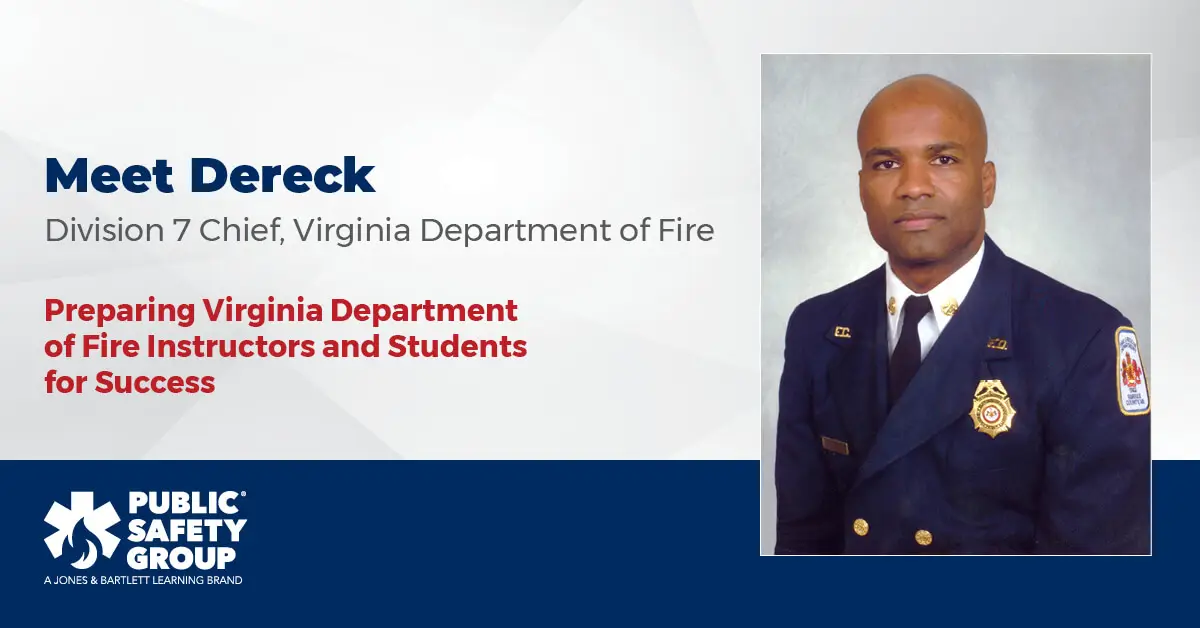Why the IAFC's Fire Officer Curriculum Works for Northern Virginia Fire and Rescue Departments

How do you prepare a state's entire fire and rescue training program for success?
Dereck Baker, Division 7 Chief, has found that 98% of students pass their Fire Officer I and II exams using PSG's Fire Officer book and Navigate curriculum, and estimates that 99% of instructors choose to use Navigate because the resources included are very beneficial to students.
A former 31-year member of the Fairfax County Fire and Rescue Department, Dereck Baker currently serves as the Division 7 Chief, where he oversees the Certification and Attendance training of all Northern Virginia Fire and Rescue departments. One of Dereck’s main focuses is the Fire Officer I and II and Chief Officer III and IV (referred to as “Fire Officer III and IV” within the state) programs. The state will soon be moving over to the Fourth Edition of the book to better meet 2020 NFPA standards.
Chief Baker took time to speak with us on experience using state of Virginia’s experience using Fire Officer: Principles and Practice, Third Edition for their Fire Officer I and II courses:
What do you like about the Fire Officer book? How does it compare to other fire officer books you’ve used in the past?
For the longest time, we used a different book, mainly because it was one of the few books available for fire officers. When I was tasked with taking over the Fire Officer program five years ago, I wanted to use a more modern textbook, and I was surprised to learn that the committees I inherited agreed despite being from all different parts of Virginia.
When we reviewed the PSG Fire Officer book, we were amazed at how up to date the book was and how it had everything we wanted in a new book. We liked the Knowledge and Skills Objectives, “You are the Fire Officer” drills, After-Action Reviews, and additional content included. The book correlated with the JPRs we needed to meet excellently. Right now, we’re teaching with an earlier NFPA 1021 standard, but we will be moving to Fire Officer, Fourth Edition to better meet the 2020 NFPA 1021 Standard for Fire Officer.
There was a concerted effort to increase the coverage of leadership concepts and application for both the Fire Officer I and Fire Officer II levels in the Fourth Edition. How well do you think we executed on that valuable topic for these future fire officers and leaders?
Based on our review of the Fourth Edition, I think you hit the topic “on the nose.” The author who wrote the book is highly respected in the fire community, and I think the work he did is great. My team was also impressed by the wide range of reviewers that assessed this book from all over the county; a lot of recognizable and respected names were in there.
In Virginia, when a firefighter reaches Officer II, he/she is a managing fire officer (as opposed to a frontline officer in Officer I). We feel this edition covers everything that a managing fire officer needs to know to work in the state of Virginia.
What do your instructors and students like about the Navigate Learning Management System?
Most of our firefighters nowadays are computer savvy after growing up using electronic devices. In Virginia, we make it optional to use Navigate, but I’d say 99% of instructors choose to use it because the extra resources it provides for students to use in their studying make the instructor’s job so much easier. For example, students can use the eBook and take ungraded Practice Quizzes to see where they stand in their knowledge. The Test Bank included in Navigate is comprehensive, and we can add in our own questions to further test student knowledge. The access code redemption process is easy, and students typically have no problems getting into their courses. I would estimate that 98% of instructors and students are happy using Navigate overall.
We train all our instructors on how to use Navigate so that instructors can see it, understand how to use it, and know how to deliver a good course through the system. We also encourage them to visit YouTube and the Navigate Training Library if they have any issues or want to truly learn about all the system can do.
What kind of success have you seen with certification using the Fire Officer book and Navigate?
I’d estimate that our pass rate is well above 95%. It’s very rare to have a class fail our Fire Officer courses. To ensure that students stay on top of things, I require that when a class ends, all work must be done within five days of the class ending. This helps keep instructors accountable for making sure their students don’t slack off by allowing them to delay required work for course completion.
Are there any closing words you’d like to share for anyone considering using PSG products?
From the very beginning, our relationship with the PSG team has been tremendous and professional. Whenever we have issues with Navigate, an email or phone call fixes it immediately.
I also love the content of the books. The real-life pictures in each chapter do a good job depicting the topic/issue and include a diverse group of folks. Together, the pictures, Knowledge and Skills Objectives, Fire Officer Tips, After-Action Reviews, and everything else create one outstanding book that’s been written and reviewed
by some of the best in our profession.
I think when we officially transition to the Fourth Edition of this book, our students and instructors will be more than happy about having it as a resource.
Learn more about Fire Office, Fourth Edition today.
For more information about the products highlighted in this Customer Spotlight or to learn more about how the Public Safety Group can help you reach your unique training goals, please contact your dedicated representative today.